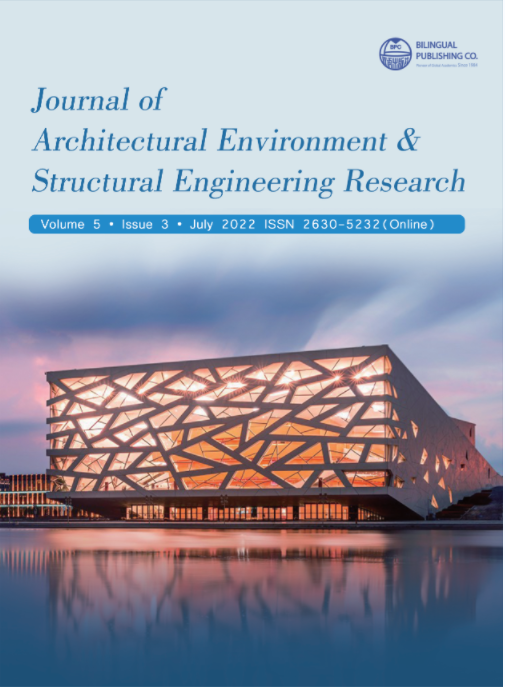-
370
-
222
-
183
-
179
-
172
3D Simulation of Battery Fire on a Large Steel Frame Structure due to Depleted Battery Piles
DOI:
https://doi.org/10.30564/jaeser.v5i3.4985Abstract
Lithium ion batteries (LIB) can rupture and result in thermal runaway and battery fires. In the process of transporting lithium ion batteries using trains, the massive collection of batteries can cause train fire and pose significant danger to the public. This is especially critical when the fire occurs amid a heavily populated metropolitan environment. This paper reports the 3D analysis of a warehouse with possible train fire due to LIB rupture and the fire propagation at a rail yard. Six critical fire cases with the battery train in close vicinity to the warehouse were considered. The six fire cases are the worst-case scenarios of a Monte Carlo simulation of different fire cases that may occur to an actual steel storage facility at the Capital Railyard, Raleigh, North Carolina. A 3D finite element (FE) frame model was constructed for the steel warehouse and the most critical fire cases were simulated. The results indicated that several structural components of the warehouse would experience large stresses and deflections during the simulated battery fires and resulting in instability to the structure. Specifically, members of the roof frame represent the most critical elements and that the members can result in large deformations as early as 4 minutes after the fire starts. Furthermore, effective utilization of fire protection can delay somewhat the fire effects and extend time to failure to 45 minutes and in one of the simulated cases, prevent structural instability. Thus, fire from LIB waste transport using train is a very realistic problem due to the thermal runaway, and the analysis performed in current study can be used as a preventive investigation technique for buildings that may be exposed to the train fire risk.
Keywords:
Lithium ion battery; Train fire; Propagation; Structural safetyReferences
[1] Armand, M., Axmann, P., Bresser, D., et al., 2020. Lithium-ion Batteries- Current State of the Art and Anticipated Developments, Journal of Power Sources. 479, 228708.
[2] Notter, D.A., Gauch, M., Widmer, R., et al., 2010. Contribution of Li-ion batteries to the Environmental Impact of Electric Vehicles. Environmental Science Technologies. 44, 6550-6556.
[3] Church, C., Wuennenberg, L., 2019. Sustainability and Second Life: The Case for Cobalt and Lithium Recycling, Technical Report, International Institute for Sustainable Development (IISD). pp. 68.
[4] Federal Register, 2007. Hazardous Materials; Transportation of Lithium Batteries. 49 CFR Parts 171, 172, 173 and 175, Pipeline and Hazardous Materials Safety Administration (PHMSA), USDOT.
[5] Houston Fire Department, 2017. “Chapman Street Fire,” Report No. 17-1120608, Houston Fire Department.
[6] Romo, S.N., 2020. Personal Communication, KTRKTV.
[7] Summer, S., Maloney, T., 2017. Fire Hazard Analysis for Various Lithium Batteries, Report No. DOT/FAA/ TC-16/17, US Department of Transportation.
[8] Wang, Q., Ping, P., Zhao, X., et al., 2012. Thermal Runaway Caused Fire and Explosion of Lithium Ion Battery. Journal of Power Sources. 208, 210-224.
[9] Long, Jr.R.T., Sutula, J.A., Kahn, M.J., 2014. Flammability of Cartoned Lithium Ion Batteries, the Fire Protection Research Foundation, Springer, New York.
[10] Larsson, F., Anderson, J., Andersson, P., et al., 2016. Thermal Modelling of Cell-to-Cell Fire Propagation and Cascading Thermal Runaway Failure Effects for Lithium-Ion Battery Cells and Modules Using Fire Walls. Journal of Electrochemical Society. 163(14), A2854-A2865.
[11] Blum, A.F., Long, Jr.R.T., 2016. Fire Hazard Assessment of Lithium Ion Battery Energy Storage Systems, Springer, New York.
[12] DNV-GL, 2020. McMicken Battery Energy Storage System Event Technical Analysis and Recommendations. Arizona Public Services Report No. 10209302-HOU-R-01.
[13] APTA, 2009. Recommended practice for Transit Bus Fire/Thermal Incident Investigation, APTA BTS-BSRP-004-08.
[14] APTA, 2009. Recommended practice for Transit Bus Electrical System Requirements Related to Fire Safe-ty, APTA BTS-BS-RP-002-07.
[15] APTA, 2009. Recommended Practice for Installation of Transit Vehicle Fire Protection Systems, APTA BTS-BS-RP-003-08.
[16] APTA, 2009. Recommended practice for Fire Safety Analysis of Existing Passenger Rail Equipment, APTA BTS-BS-RP-005-00.
[17] APTA, 2009. Recommended practice for Fire Detection System Inspection and Testing, APTA RTSC-S-042-03.
[18] NFPA, Standard for Fixed Guideway Transit and Passenger Rail Systems, NFPA-130, National Fire Protection Association, Washington, D.C, 2020.
[19] IBC (International Building Code), 2018. International Code Council, Washington, D.C.
[20] LaMalva, K., 2018. Structural Fire Engineering, ASC/SEI Manual of Practice.
[21] MBMA, 2010. Fire Resistance Design Guide for Metal Buildings Systems, Manual, Metal Building Manufacturers Association, Ohio.
[22] MBMA, 2018. Metal Building Systems Manual, Handbook. Metal Building Manufacturers Association, Ohio.
[23] MBMA, 2018. Seismic Design Guide for Metal Building Systems, Metal Building Manufacturers Association, Third Edition, Ohio.
[24] AISC (American Institute of Steel Construction), 2017. Steel Construction Manual, 15th Edition. Chicago.
[25] Mira, J., Braxtan, N.L., Chen, S.E., et al., 2021. Battery Train Fire Risk on a Steel Warehouse Structure. Journal of Architectural Environment and Structural Engineering Research. 4, 3.
[26] Abaqus, 2018. User’s Manual, Abaqus Inc., Johnston, RI.
[27] Haehler, R., 2011. Steel Design Guide 25: Frame Design Using Web-Tapered Members. Steel Design Guide Series Number 25, AISC.
[28] ASCE/SEI, 2016. American Society of Civil Engineers, ASCE Standard 7-16 Minimum Design Loads and Associated Criteria for Buildings and Other Structures. Virginia.
[29] EN 1993-1-1, 2005. Eurocode 3: Design of Steel Structures - Part 1-2: General rules – Structural Fire Design. Brussels: Comité Européen de Normalisation.
[30] EN 1991-1-2, 2009. Eurocode 1: Actions on Structures - Part 1-2: General Actions - Actions on Structures Exposed to Fire. Brussels: Comité Européen de Normalisation.
[31] Sun, P., Huang, X., Bisschop, R., et al., 2020. A Review of Battery Fires in Electric Vehicles. Fire Technology. 56, 1361-1410.




 Nicole Braxtan
Nicole Braxtan





